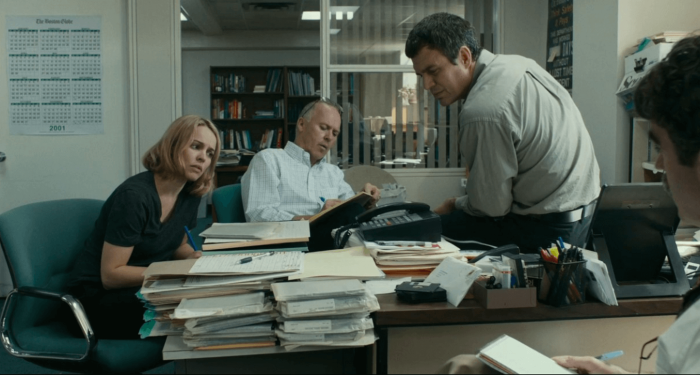Ben Affleck and Javier Bardem in Terrence Malick’s “To the Wonder.” | MAGNOLIA PICTURES
“To the Wonder” is the kind of muddle only a great filmmaker can make. If cinema consisted of images alone, this film would be masterful. Unfortunately, Terrence Malick also supplies two of his characters with clunky voice-overs. As a priest (Javier Bardem) ponders his doubts about his faith and growing disconnect from God, he doesn’t sound like a middle-aged man of the cloth. Instead, he resembles a college freshman from an extremely religious background pulled away from faith for the first time.
Malick’s self-awareness about his voice-overs has been steadily decreasing, as they’ve deliberately strayed further from ordinary speech. Sissy Spacek’s narration in his 1973 debut “Badlands” was delivered in the purplest of prose, but it fit the character. Part of the problem with “To the Wonder” is that it doesn’t offer credible characters, just postures.
Malick’s latest offers pleasures, frustrations
Neil (Ben Affleck) is traveling in Europe when he meets Marina (Olga Kurylenko), a Ukrainian single mother living in Paris. He relocates Marina and her daughter Tatiana to his home in Oklahoma, where he works as an environmental inspector, but their relationship loses its intensity. Marina gets to know a Catholic priest, Father Quintana, when she attends the church where he says Mass, but when her visa runs out, she has to return to France. Neil gets back together with his ex-girlfriend Jane (Rachel McAdams) for a while, but later returns to Marina and brings her back to Oklahoma.
Since “The Thin Red Line,” which marked a return from a 20-year break from filmmaking, Malick has cast Hollywood stars in his films, only to give them tiny roles or leave most of their parts on the cutting room floor. If Sean Penn fans went to see “The Tree of Life” expecting to see much of him, they must have been sorely disappointed, since the actor only appears for 10 minutes. Malick shows a similar perversity in his use of Affleck, whom he calls upon to pose, not act. Affleck merely looms in the background of most of his scenes, looking glum. He has very few lines of dialogue. Only in a fight scene does Malick require him to do anything particularly challenging. This near-invisibility lets the film evade coming to terms with his oft-irresponsible behavior toward Marina.
“To the Wonder” builds on the visual style of “The Tree of Life,” while discarding most of that film’s more experimental elements. The camera is constantly in motion, usually following a character as they walk forward or dance. Malick relies heavily on jump cuts, several times crossing continents in the space of a quick edit. He also likes shooting at noon, when the sun is at its brightest, or at dusk.
“To the Wonder” is the only one of Malick’s six films to take place entirely in the contemporary world. It combines trips to big-box superstores and suburban laundromats with scenes of poverty and illness, mostly witnessed by Father Quintana. All along, Malick awkwardly balances this newfound realism with the repeated image of Kurylenko dancing in fields with a piece of cloth. How does she find so much time to twirl around joyfully while Father Quintana is busy uncovering new evidence of what a fallen world we live in?
Part of the problem with “To the Wonder” is that Malick’s style has been copied left and right, especially since he made his return to regular filmmaking with “The Tree of Life” two years ago. Critics of “To the Wonder” claim it looks like a perfume ad. It would be more accurate to say that many perfume ads have ripped off Malick’s style, but that doesn’t solve the problem of its overfamiliarity. For better (“Upstream Color”) or worse (“Beasts of the Southern Wild”), Malick’s signature is all over contemporary American indie cinema. He’s become a patron saint of sorts to directors like Shane Carruth and David Gordon Green.
“To the Wonder” has much to recommend it but, like “The Tree of Life,” it’s the kind of work that’s bound to produce snarky reviews by critics who have to turn in their pieces an hour after seeing a challenging film. I’m very sympathetic to Malick’s project of creating an American art cinema, especially one made far from the West and East Coasts. (This is his first film produced and distributed entirely outside the studio system.)
“To the Wonder” is also a Christian film, set in the land of mega-churches but speaking about spirituality in a far more rarefied language. Nevertheless, he’s repeating himself, with diminishing returns. There are many pleasures in “To the Wonder,” but many frustrations to go along with them. I hope it turns out to be a transitional film toward a new phase in Malick’s work.
TO THE WONDER | Directed by Terrence Malick | Magnolia Pictures | In English and French and Spanish with English subtitles | Opens Apr. 12 | Landmark Sunshine | 143 E. Houston St., btwn. First & Second Ave. | landmarktheatres.com



































